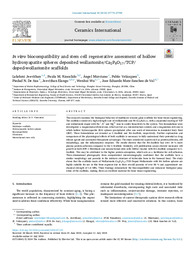Por favor, use este identificador para citar o enlazar este ítem:
https://hdl.handle.net/11000/34033Registro completo de metadatos
| Campo DC | Valor | Lengua/Idioma |
|---|---|---|
| dc.contributor.author | Jeevithan, Lakshmi | - |
| dc.contributor.author | Riosalido, Paula M. | - |
| dc.contributor.author | Murciano, Angel | - |
| dc.contributor.author | Velásquez, Pablo | - |
| dc.contributor.author | De Aza, Piedad | - |
| dc.contributor.author | Elango, Jeevithan | - |
| dc.contributor.author | Wu, Wenhui | - |
| dc.contributor.author | Cueva Sanchez, Eduardo Jose | - |
| dc.contributor.other | Departamentos de la UMH::Ciencia de Materiales, Óptica y Tecnología Electrónica | es_ES |
| dc.date.accessioned | 2024-11-27T08:38:36Z | - |
| dc.date.available | 2024-11-27T08:38:36Z | - |
| dc.date.created | 2024-10-15 | - |
| dc.identifier.citation | Ceramics International, Volume 50, Issue 20, Part A, 2024, Pages 37779-37789 | es_ES |
| dc.identifier.issn | 1873-3956 | - |
| dc.identifier.issn | 0272-8842 | - |
| dc.identifier.uri | https://hdl.handle.net/11000/34033 | - |
| dc.description.abstract | This research examines the biological behavior of multilayer ceramic-glass scaffolds for bone tissue engineering. The scaffolds consist of a high-strength core of wollastonite and P6 (Ca2P6O17), with a sequential coating of TCP and wollastonite doped with Na+, K+ and Mg2+ ions to confer bioactivity to the system. Two formulations were investigated: a magnesium-deficient one, which served as a microstructure control, and a magnesium-rich one in which hollow hydroxyapatite (HA) spheres precipitated after one week of immersion in simulated body fluid (SBF). These formulations are denoted as C-Scaffold and HA-Scaffold, respectively. Further exploration and comparison of the physiological effects of both scaffolds is necessary to fully understand their potential as drug release agents and associated therapeutic advantages. The study considered aspects such as protein adhesion, cell morphology, and the inflammatory response. The results showed that the HA-Scaffold had over 34 % more plasma protein adhesion compared to the C-Scaffold. Similarly, cell proliferation assays showed increased cell growth in both HFF-1 fibroblasts and mesenchymal stem cells (MSCs) treated with HA-Scaffold compared to CScaffold. This may be attributed to the higher protein adsorption, which acts as a facilitator for cell adhesion. Three-dimensional photography from computerized microtomography confirmed that the scaffolds have a similar morphology and porosity to the intricate structure of trabecular bone in the humeral head. The study shows that the scaffolds made of Wollastonite/Ca2P6O17/TCP/Doped-Wollastonite with HA hollow spheres are highly suitable for use in this bone segment due to their overall porosity of over 86 % and approximate mechanical strength of 1.6 MPa. These findings demonstrate the biocompatibility and enhanced biological properties of the scaffolds, making them an excellent material for bone tissue engineering. | es_ES |
| dc.format | application/pdf | es_ES |
| dc.format.extent | 11 | es_ES |
| dc.language.iso | eng | es_ES |
| dc.publisher | Elsevier | es_ES |
| dc.rights | info:eu-repo/semantics/openAccess | es_ES |
| dc.rights.uri | http://creativecommons.org/licenses/by-nc-nd/4.0/ | * |
| dc.subject | Multilayer scaffolds | es_ES |
| dc.subject | Hydroxyapatite hollow spheres | es_ES |
| dc.subject | Biocompatibility | es_ES |
| dc.subject | Fibroblasts | es_ES |
| dc.subject | Mesenchymal stem cells | es_ES |
| dc.subject.other | CDU::6 - Ciencias aplicadas | es_ES |
| dc.title | In vitro biocompatibility and stem cell regenerative assessment of hollow hydroxyapatite spheres deposited wollastonite/Ca2P6O17/TCP/ doped-wollastonite scaffolds | es_ES |
| dc.type | info:eu-repo/semantics/article | es_ES |
| dc.relation.publisherversion | https://doi.org/10.1016/j.ceramint.2024.07.141 | es_ES |

Ver/Abrir:
2024-Ceram Inter Jevee Paula.pdf
13,42 MB
Adobe PDF
Compartir:
 La licencia se describe como: Atribución-NonComercial-NoDerivada 4.0 Internacional.
La licencia se describe como: Atribución-NonComercial-NoDerivada 4.0 Internacional.
.png)